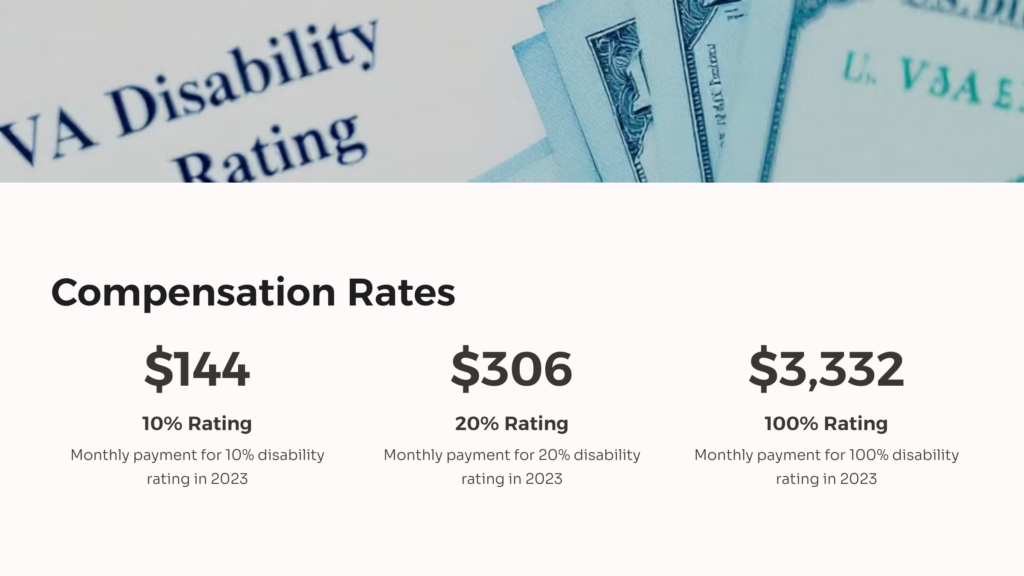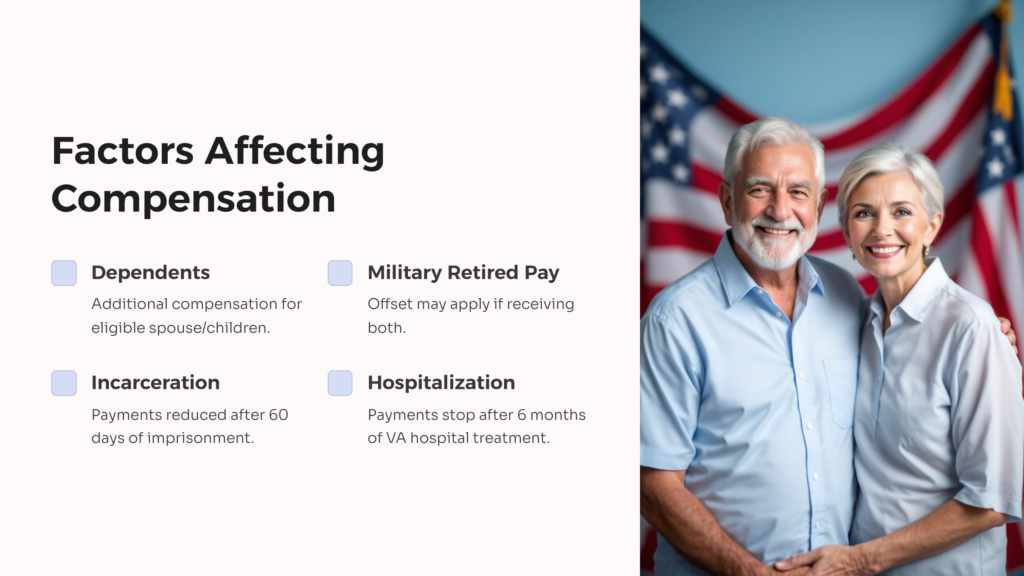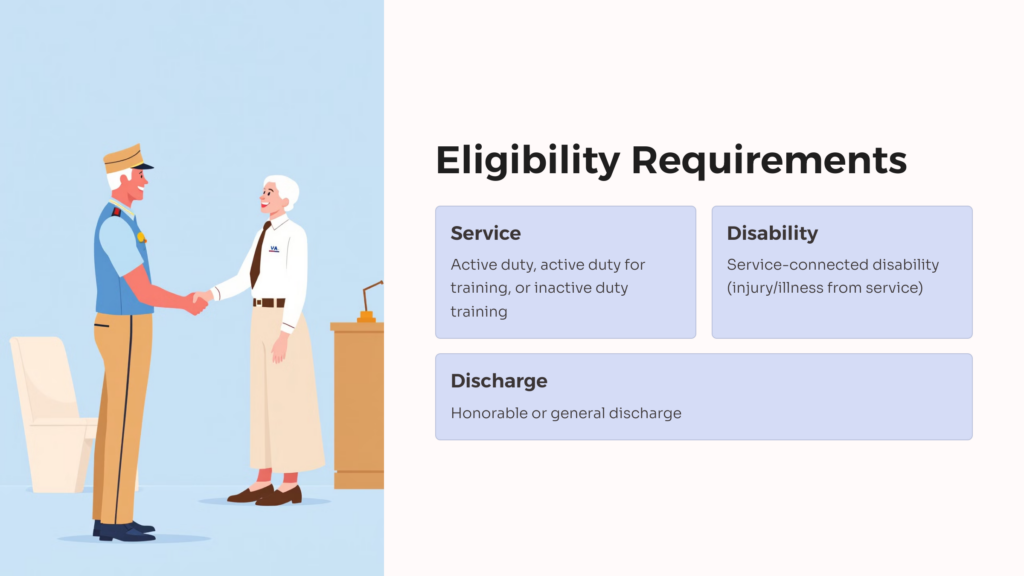The Department of Veterans Affairs (VA) provides monthly disability compensation payments to veterans with service-connected disabilities. The amount of monthly compensation depends on the veteran’s combined disability rating, which is based on the severity of the service-connected conditions.

Compensation Rates for Veterans with a 10% to 20% Disability Rating
Veterans with a 10% disability rating receive $144 per month in compensation in 2023. For a 20% rating, the monthly payment is $306. These rates are standard regardless of whether the veteran has one or multiple conditions. A veteran with two 10% disability ratings would receive $288 per month.
Compensation Rates for Veterans with a 30% to 100% Disability Rating
Disability ratings from 30% to 100% have monthly compensation amounts on a sliding scale. For example, a 50% rating has a monthly payment of $936 while a 100% rating results in $3,332 monthly. Veterans with multiple conditions receive a combined disability rating, which determines the compensation amount.
A veteran with a 30% rating for one condition and a 20% rating for another would have a combined rating of 40%. This would equal $569 per month in compensation.

How to Use the Tables to Find Your Monthly Payment
The VA publishes compensation tables each year with the exact monthly rates for each percentage rating from 10% to 100%. Veterans can use these tables to look up their combined rating and see the corresponding monthly amount they should receive.
The tables include payments for veterans with and without spouse/dependents. Compensation rates are higher for veterans with dependents.
Past Rates
Disability compensation rates increase most years based on cost-of-living adjustments (COLA). For example, a 50% rating paid $859 monthly in 2018 versus $936 monthly in 2023. Past compensation tables are available on the VA website.
Review Other VA Compensation Rates
In addition to the basic monthly rates, veterans may be eligible for special monthly compensation or deductibles based on specific circumstances.
- Special monthly compensation provides higher rates for severe disabilities or loss of limbs/senses.
- Deductible amounts are taken out of compensation for some Veterans receiving military retirement pay.
All of these additional rates can also be found in the annual VA compensation tables.
Review Current VA Disability Compensation Rates
The VA publishes new compensation tables each December showing the rates for the upcoming year. Veterans should review the current year’s rates to ensure they are receiving the proper monthly entitlement.
The 2023 compensation rates are available on the VA website or through this direct link: VA Disability Compensation Rates for 2023.
Factors That May Affect Your Monthly Compensation Payments

Certain circumstances can increase or decrease monthly compensation beyond the base rating amount:
- Dependents: Additional compensation is paid for eligible spouse/children.
- Military Retired Pay: An offset may be taken if a Veteran receives both.
- Incarceration: Payments are reduced after 60 days of imprisonment.
- Hospitalization: Payments stop after 6 months of VA hospital treatment.
- Duty Status: Reservists receive a reduced rate.
Veterans should notify the VA immediately if any of these factors apply to avoid payment issues.
When Will I Get My First Payment?
After submitting a disability claim, it typically takes 3-5 months to receive the first monthly compensation payment. Retroactive benefits are included covering the period since the claim was filed. Initial payment may take longer if additional evidence is needed.
VA Disability Ratings
The VA assigns percentage disability ratings to compensate veterans for service-connected conditions. Higher ratings are given for more severe disabilities.
View Your VA Disability Ratings
Veterans can view their current disability ratings on eBenefits or by contacting their VA Regional Office. The ratings are listed by each condition. There is an overall combined rating used for compensation.
How We Assign VA Disability Ratings
The VA uses the Schedule for Rating Disabilities to evaluate and assign ratings based on:
- Diagnosis of the condition
- Severity of symptoms
- Impact on social/occupational functioning
Ratings may be 0%, 10%, 30%, etc. Higher ratings are assigned for conditions that have worsened over time.
How We Determine Combined VA Disability Ratings
Veterans often have multiple ratings. The VA uses a formula to determine a single combined rating, which is not just an average.
For example:
50% rating
20% rating Combined: 60% rating
The combined rating is usually lower than the sum of all ratings. A tool is available to calculate combined ratings.
Combined Ratings
Veterans do not receive separate compensation for each disability. The combined rating determines a single monthly payment amount.
For example, a veteran with a 30% rating and a 20% rating receives compensation for the combined 40% rating, not separate payments.
Why Do I Need to Know My Disability Rating?
There are a few key reasons it is important to understand your VA disability ratings:
- Monthly compensation is based on the combined rating.
- Ratings determine eligibility for other VA benefits.
- Higher ratings may qualify for additional VA dependents benefits.
- Veterans may want to appeal for a higher rating on a condition.
What If I Disagree With My Disability Rating?
Veterans who disagree with their rating can file an appeal for a higher rating. New medical evidence is usually required to support a worsening of the condition.
VA disability ratings can be appealed multiple times if denied, first to a Decision Review Officer, then to the Board of Veterans Appeals.
VA Compensation Calculation
The monthly dollar amounts for VA disability compensation are determined based on complex formulas set in federal regulations.
How VA Calculates Compensation Rates
Several factors are considered annually in determining VA compensation:
- Basic pay rates for military ranks
- Cost-of-living adjustments (COLA)
- Annual round down provision
- Reductions for retirees receiving pay
Rates differ for veterans with dependents versus without.
Cost-of-Living Adjustments (COLA)
Most years, disability rates are increased based on COLAs determined by the Social Security Administration. COLA is the percentage increase in cost of goods/services.
For example, the COLA was 5.9% for 2023 benefits, so rates rose by 5.9% across rating levels. This helps maintain purchasing power.
38 CFR Book C, Schedule for Rating Disabilities
The Code of Federal Regulations defines disability compensation. Section 4.25 outlines how to calculate combined ratings.
Other sections establish the basic monthly entitlement amounts for each rating percentage (10%, 20%, etc).
Supplements for Book C
VA regulations authorize special monthly compensation payments in certain cases, such as:
- Anatomical loss of limbs or sensory organs
- 100% disability plus another 60% disability
These supplements provide higher compensation beyond the basic combined rating.
Disability Conditions & Ratings
The VA evaluates medical evidence to determine disability ratings based on criteria in the Schedule for Rating Disabilities. Higher ratings are assigned for more severe symptoms and functional impact.
The Musculoskeletal System
Common examples:
- Knee arthritis with pain and limited motion may be 10-20%.
- Back strain with muscle spasms and decreased range is often 20%.
- Severe back impairment with radiating pain can be 40% or higher.
The Organs of Special Sense
Common examples:
- Hearing loss resulting in trouble communicating may be 10%.
- Loss of vision in one eye could be 30%.
- Complete loss of hearing in both ears may be rated at 100%.
The Respiratory System
Common examples:
- Mild asthma with occasional symptoms may be 10%.
- Moderate asthma with daily inhaler use could be 30%.
- Severe respiratory deficiency could be 100%.
The Cardiovascular System
Common examples:
- Hypertension controlled with medication may be 10%.
- Heart disease with occasional chest pain and fatigue could be 30-60%.
- Severe heart failure symptoms could be 100%.
Other Conditions
- Mental health disorders like PTSD are rated based on occupational/social impairment.
- Scars are rated on characteristics like pain, disfigurement, and size.
- Chronic conditions like diabetes are rated higher if complications develop.
Queries and Responses
Here are answers to some frequently asked questions about VA disability compensation and ratings.
Am I eligible to use this tool?
The disability compensation rate tables are public information available to anyone. Veterans do not need an account to view them.
What can I see once I sign in?
By signing into eBenefits or VA.gov with a DS Logon, Veterans can view their own current disability ratings and past notification letters. This is personalized information unique to you.
What if I have more questions?
Please contact your VA Regional Office for assistance with any additional questions related to your disability compensation, ratings, eligibility, or benefits payments.
Veteran Support and Services
The VA offers resources to support veterans’ overall health and wellbeing.
Get Help from Veterans Crisis Line
The Veterans Crisis Line is a free, confidential hotline for veterans in crisis or distress. Call 1-800-273-8255 and press 1. Support is available 24/7.
Veteran Readiness and Employment (VR&E)
VR&E helps veterans with service-connected disabilities find stable employment. Other services include resume development, training, and career counseling.
VA Benefit Access
Understanding eligibility for VA disability compensation is key for veterans seeking access to these monthly benefits.
Am I Eligible for VA Disability Compensation?

Basic requirements for eligibility include:
- Served on active duty, active duty for training, or inactive duty training
- Have a stable service-connected disability (injury/illness that began in or was aggravated by service)
- Received an honorable or general discharge
There are additional criteria related to length of service for Reserve/National Guard members.
How Do I Get Benefits That Cover Specific Disabilities?
Submitting a claim is the first step to seek compensation for a disability. Supporting medical records will need to confirm a current diagnosis that is linked to an event or injury during qualifying service.
The PACT Act Expands Benefit Access for Veterans Exposed to Burn Pits and Other Toxic Substances
This law presumes certain respiratory conditions and cancers are related to burn pit exposure during service in specific locations. Veterans who qualify no longer have to prove their illness is service-connected.
Claim Filing
Submitting a well-documented disability claim is essential to establish eligibility for monthly tax-free compensation.
How Do I File a Claim for Compensation?
You can file a claim online through eBenefits, work with an accredited representative, or visit a VA Regional Office. Details on required documents:
What Conditions Are Covered by These Benefits?
Any mental or physical disability that began during or was aggravated by military service may be eligible for compensation. Common examples:
- Hearing loss and tinnitus
- Back, knee, ankle conditions
- PTSD, depression, anxiety
- Sleep apnea, asthma
- Hypertension, heart disease
What Should I Do If I Received an Other Than Honorable, Bad Conduct, or Dishonorable Discharge?
You may request a Character of Discharge review if you believe your service was honorable. If upgrade is denied, you can apply for a discharge upgrade through your branch of service.
Honorable discharge is required for VA compensation, so this should be resolved before filing a claim. Discuss your situation with a VA representative.
Additional Information
There are extensive resources available to help veterans learn more about VA disability compensation and health benefits.
Get More Information
VA Disability Compensation is the main page for an overview of the program.
Compensation 101 has videos explaining the claim process.
Ask a Question allows you to research previously asked questions about compensation.
Learn More About VA Compensation Rates
- Benefit Rates Tables: Official current and past compensation tables.
- Special Monthly Compensation: Rates for severely disabled veterans.
- Concurrent Retirement and Disability Pay: Rules for military retirees.
Frequently Asked Questions
Here are answers to some other common searches related to VA disability compensation and ratings:
What Are the VA Disability Rates for 2023?
The basic VA disability rates increased by 5.9% for 2023 based on the cost-of-living adjustment. View the 2023 payment rates.
What Is the 70% 40% Rule for VA Disability?
This refers to special monthly compensation provided if a veteran has one disability rated 70% along with another disability rated at least 40%.
Is My VA Rating for Life?
VA disability ratings are not always permanent. Ratings can be decreased if a condition improves. They can also be increased if a condition worsens. Veterans should keep up with medical care and advise the VA of any changes.
What Is the VA Rating for Anxiety?
Anxiety is rated under the General Rating Formula for Mental Disorders. Mild symptoms may be 10%. Ratings of 30% to 100% are provided for more severe occupational and social impairment.
Conclusion
I hope this overview on VA disability compensation rates, ratings, eligibility, and claim filing helps provide clarity for veterans seeking access to these important benefits. Please consult with a VA representative if you need guidance on how to initiate or increase your disability benefits. The VA is here to support veterans and make the process as smooth as possible.
 AllVeteran.com Advisors
AllVeteran.com Advisors
With expertise spanning local, state, and federal benefit programs, our team is dedicated to guiding individuals towards the perfect program tailored to their unique circumstances.


















